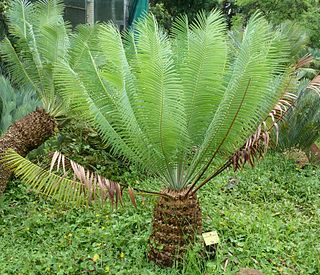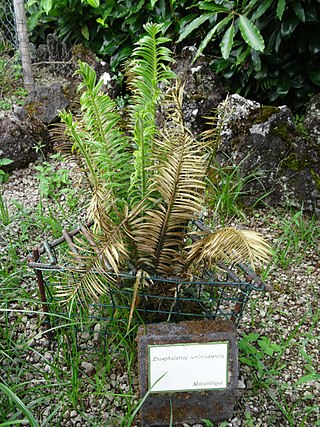
Encephalartos villosus is a South African cycad occurring from the East London vicinity, where it is found near the coast, to the northern border of Eswatini (Swaziland) where it may grow as far as 100 km inland. The species is common throughout its range and is the most frequently cultivated in Southern Africa, largely because of its affordable price. As a result of its large geographical distribution, it is notably variable in leaf and cone shape.

Encephalartos ferox, a member of the family Zamiaceae, is a small cycad with 35 cm wide subterranean trunk. It gets its name from the Latin word ferocious, likely from the spine-tipped lobes on the leaves of the plant. It is found naturally on the south-eastern coast of Africa where it has been used by local people for its starch content. It is considered to be one of the most popular cultivated cycads.

Encephalartos longifolius is a low-growing palm-like cycad in the family Zamiaceae. It is endemic to South Africa and is commonly known as Thunberg's cycad, breadpalm or broodboom. This cycad is listed as near threatened in the IUCN Red List of Threatened Species.
Encephalartos brevifoliolatus, the escarpment cycad, is a cycad in the African genus Encephalartos. It is extinct in the wild. The escarpment cycad was found in short grasslands in the very open Protea savanna on the northern Drakensberg escarpment in South Africa's Limpopo Province. These plants are used to growing on large cliffs.

Encephalartos senticosus is a species of cycad in the family Zamiaceae native to the Lebombo Mountains of Mozambique, Eswatini (Swaziland), and the KwaZulu-Natal province of South Africa. Prior to its description in 1996, Encephalartos senticosus had been confused with the closely related and sympatric Encephalartos lebomboensis. Both species are commonly known as the Lebombo cycad.

Encephalartos whitelockii is a species of cycad that is native to Uganda.

Encephalartos princeps is a species of cycad that is native to Eastern Cape Province of South Africa.

Encephalartos paucidentatus is a species of cycad.

Encephalartos natalensis, the Natal cycad or giant cycad, is a species of cycad that is endemic to the Qumbu and Tabankulu areas of the northern part of the Eastern Cape, and through most of KwaZulu-Natal. The number of mature individuals of this species is declining and the International Union for Conservation of Nature has assessed its conservation status as being "near threatened".

Encephalartos friderici-guilielmi is a species of cycad that is native to Eastern Cape province and KwaZulu-Natal province of South Africa at elevations of 700 up to 1400 meters.

Encephalartos eugene-maraisii is a species of cycad in the family Zamiaceae. It is endemic to South Africa, where it is limited to Limpopo. It is known as the Waterberg cycad.

Encephalartos cycadifolius is a species of cycad that is native to the Winterberg mountains to the north of Bedford in the Eastern Cape province, South Africa. It is found at elevations from 1,200 to 1,800 meters.

Encephalartos inopinus is a species of cycad that is native to Limpopo Province, South Africa.

Encephalartos hildebrandtii is a species of cycad in the Zamiaceae family. It is native to Kenya and Tanzania at elevations from sea level to 600 metres (2,000 ft). The species is named for the German explorer Johann Maria Hildebrandt.
Encephalartos macrostrobilus is a species of cycad in Africa. It is found only in Moyo District, northwestern Uganda, which is populated predominantly by the ethnic Madi.

Encephalartos aemulans, the Ngotshe cycad, is a species of cycad endemic to South Africa. It is listed by the IUCN as Critically Endangered and by CITES in Appendix I. Only 100-250 are believed to be left, with a decreasing population trend. Its main threat is collecting of wild specimens.

Encephalartos cerinus or Waxen Cycad is a species of cycad in Africa.

Encephalartos lanatus is a species of cycad, a plant belonging to the family Zamiaceae growing in Mpumalanga, South Africa. Its specific epithet, lanatus, means wooly in Latin.

Encephalartos umbeluziensis is a species of cycad from Africa.
Encephalartos kanga, also known as Mnanasi Pori is a species of cycad in the family Zamiaceae. It is native to Tanzania. The plant was formally described as a new species in 2007 by Tamás Pócs and Quentin Luke.


















